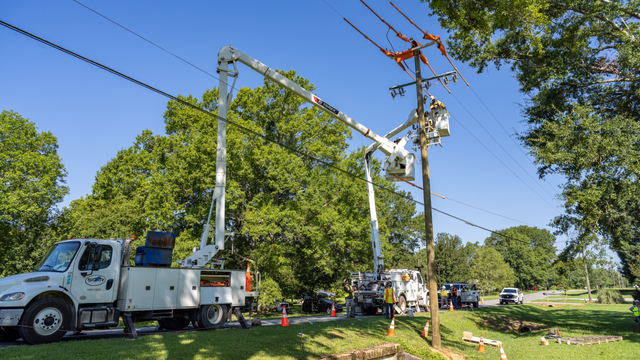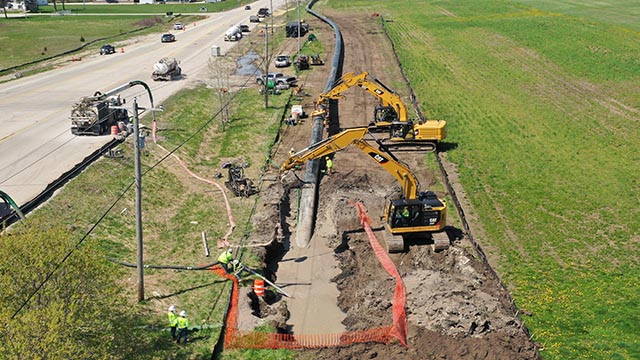Since its humble roots in the late 1800s, the U.S. electric grid has evolved, dutifully moving the electrons that did everything from powering the nation’s industrialization and wartime machines to being the lifeblood of today’s factories, computers and appliances.
As that infrastructure continues to show its age, a repowering of the power industry through a transformation toward lower- or zero-carbon generation to power a cleaner, even more electrified world – from the electric vehicle (EV) sector to automation and beyond – is afoot, forced by today’s complex, diverse and unyielding challenges.
Droughts, floods, wildfires, hurricanes and other extreme weather events attributed to climate change increasingly are straining the grid, stoking questions about its resilience. In May, Reuters reported that power outages have more than doubled in the past six years compared to the previous six, according to the media outlet’s examination of federal data.
As the global push for decarbonization intensifies, the U.S. clean energy business — power from the sun and the wind, both on land and offshore — is booming, forcing utilities to sort out the strategy and investment needed to accommodate those green sources of power. Pressure to make that happen is coming from the top of the U.S. political establishment, with President Joe Biden’s administration ambitiously wanting a decarbonized grid by 2035 and zero emissions economywide 15 years after that.
The electrification of the nation’s transportation sector is accelerating, prompting the power sector to accommodate the ever-increasing charging demands — now rivaling aging infrastructure as a chief concern of electric utilities. Regulations continue to shift in fueling uncertainties, and cyber threats haven’t abated, exposing grid vulnerabilities.
All the while, new technologies such as hydrogen — widely viewed as an ascending star in tomorrow’s energy ecosystem — and wider use of battery storage and distributed energy sources are enjoying greater attention, giving utilities even more to think about as pressures mount for them to reimagine tomorrow’s diversified, balanced energy portfolios.
Despite the headache-inducing headwinds, opportunity knocks, most notably in the infusion of hundreds of billions of dollars in available federal funding meant to modernize the grid to lower the United States’ carbon footprint.
The Black & Veatch 2022 Electric Report — based on survey data from roughly 250 U.S. electric sector stakeholders — details it all, shining a light on the power sector repowering itself to bolster its reliability, resilience and responsiveness.
Grid Integration of Renewables, Aging Infrastructure Top Challenges
With ever-widening adoption of renewable energy, it stood to reason that integrating green energy onto the grid last year surpassed aging infrastructure as the industry’s top challenge for the first time in our reports in more than a decade. And it was no fluke.
Renewable integration tied aging infrastructure atop the list this year, with roughly three in 10 survey responses citing either as their foremost challenge. Staffing issues continue to be a headwind, with a combined 43 percent either citing the lack of a skilled workforce (22 percent) or the industry’s aging workforce (21 percent) as challenging. Environmental regulations drew one-quarter of the responses in rounding out the top five.
Cybersecurity – sixth in 2020 before rising to second last year – fell to eighth this year at 18 percent, giving way to tightly grouped concerns about reliability (21 percent) and planning and forecasting uncertainty (19 percent).

By virtually any metric, the growth of renewable energy remains robust. In August, the U.S. Energy Information Administration (EIA) reported that renewable sources such as wind, solar and hydropower are expected to account for 22 percent of U.S. electrical generation, up from 20 percent each of the past two years. The EIA anticipates that figure will rise to 24 percent next year as other generation sources such as coal and nuclear are retired in some parts of the United States.
Longer term, the EIA forecasts in its 2022 Annual Energy Outlook – widely considered the gold standard of U.S. energy projections – that the share of renewables in the U.S. electricity generation mix will more than double from last year to 2050. This comes as state and federal policies continue to incentivize investment in green energy resources for power generation and transportation fuels. New technologies are expected to continue driving down the cost of wind and solar generators, stoking their competitiveness in the electricity market.
More than ever, given the robust projections for renewables, utilities will feel added pressure to bolster the flexibility and resilience of their grids, adding battery storage and advanced inverters to accommodate the rapid transition to a greener energy ecosystem.
Promisingly, that’s something clearly on the sector’s radar. When asked about their top concerns for grid development over the next three to five years, more than half of respondents – 53 percent – pointed to the generation mix, with fewer traditional baseload units and more utility-scale renewable sources. That’s narrowly second only to supply chain issues for equipment (54 percent), a lingering headache from the global COVID-19 pandemic.
Workforce issues again are worrisome to the survey takers. The lack of qualified workers to engineer, maintain and operate the more complex system came in a distant third at 25 percent – tied with the regulatory lag in meeting the needs for system changes. Questions about the availability of talent – made more acute by a tight job market and an ever-thinning pool of recruits who enjoy more career options and greater leverage for various reasons – drew 24 percent, followed by the ability to invest in and maintain a more resilient grid (21 percent).
Yet when it comes to funding, at this crucial moment, there’s reason for optimism, courtesy of federal taxpayers.

Uncle Sam’s Help Spurs Opportunity
Deep worries about the resilience of the U.S. grid, and the imperative to dramatically modernize it to bring about climate-resilient infrastructure while accommodating ever-growing charging needs of electric vehicles, have become a Capitol Hill priority. Federal lawmakers are aware of the enormous price tag that such long-overdue grid upgrades carry, and they have responded with a generational influx of funding and, by extension, optimism.
With taxpayer help already in the pipeline through the $1.2-trillion Infrastructure Investment and Jobs Act (IIJA) signed into law by President Joe Biden in late 2021, the Inflation Reduction Act (IRA) enacted in August commits an additional $369 billion over the next decade to energy security and climate change efforts. The goal: reduce carbon emissions by 40 percent by 2030, though current investment in electric infrastructure to get there still doesn’t match the need.
Even so, survey respondents appeared forward-looking and receptive to greener energy sources when asked where they’ll be investing more in generation capacity over the next five years in their regions. More than half – 54 percent – cited energy storage, outdistancing solar (37 percent), microgrids and other distributed energy resources (20 percent), onshore wind (16 percent) and hydrogen (19 percent), which has emerged as a rising star in tomorrow’s energy ecosystem. Nuclear power – now accounting for one-fifth of the nation’s electricity supply – drew 12 percent of responses amid renewed attention for its potential in helping reduce greenhouse gas emissions blamed for global warming and extreme weather events such as floods and wildfires.

The Promise of Hydrogen
When it comes to what methods utilities expect to include in helping meet their clean energy and emissions reduction goals over the next decade and beyond, our survey showed a profound intention to migrate to a cleaner, greener energy landscape.
Over the next 10 years, nearly 70 percent of respondents said they planned to make traditional fossil-fuel generation more efficient, though that approach drew only 16 percent of responses beyond that timeframe. Natural gas, favored by three-quarters of respondents for the next 10 years, slumped to 24 percent longer term. Sixty percent said they looked to retire fossil-fueled generation sites by 2032.
Over the next decade, the energy sector expects solar (83 percent) and wind (70 percent) to help meet its clean energy goals or cut their emissions and carbon output, presumably because those options have established, matured technology and competitive costs. Those numbers drop to below 30 percent beyond 10 years, giving way to more deployments of hydrogen (60 percent) and battery energy storage – at 64 percent, the most-cited option beyond the next decade amid expectations that the costs of those technologies at scale will continue to decline, widening adoption.
At least for now, while utilities envision hydrogen as tomorrow’s transcendent energy source, the technology remains unproven. Still, ambitious projects underway hope to eliminate the uncertainty.
A shining example: Black & Veatch announced earlier this year that it has been chosen by Mitsubishi Power Americas and Magnum Development to provide engineering, procurement and construction (EPC) services for what will be the world’s largest industrial green hydrogen production and storage facility.
As the keystone of the Advanced Clean Energy Storage project in Delta, Utah, the hub will be adjacent to the Intermountain Power Agency’s (IPA) IPP Renewal Project and support that 840-MW, hydrogen-capable gas turbine combined cycle power plant being built. That plant initially will run on a blend of 30 percent green hydrogen and 70 percent natural gas starting in 2025 before incrementally expanding to using 100 percent hydrogen two decades later.
With a $504-million commitment from the U.S. Department of Energy, the hydrogen hub initially will be designed to convert more than 220 megawatts (MW) of renewable energy daily to 100 metric tons of green hydrogen that will be stored in two sprawling salt caverns. Storing excess renewable energy as hydrogen yields a long-term, long-duration energy storage solution, allowing renewable energy to be deployed in times of highest demand, helping balance load and generation across time and space.
While the Utah project illustrates the promise of tomorrow’s energy ecosystem, utilities, regulators and other industry stakeholders must commit to and collaborate on forward-thinking approaches that virtually are certain to be based on cleaner, greener options, using new strategies, access to technology, proactive investments and aggressive planning.
_
Laszlo von Lazar is president of Black & Veatch’s Energy & Process Industries (E&PI) business and serves on the company’s board of directors and leadership team. Before being named to head E&PI, he was president of BV Operations and was a key architect in successfully establishing the group as part of a companywide transformation. Von Lazar joined Black & Veatch in 2019 to guide global projects for the company’s previous power organization, for which he led engineering, procurement, construction, project controls, quality and business excellence. His 33 years of experience, including global project leadership for GE and Bechtel, comprises work in conventional power generation, solar and wind generation, transmission and distribution, oil and gas, and industrial markets.







